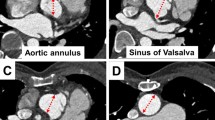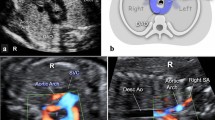Abstract
Dilatation of the ascending aorta is an important sequel in conotruncal anomalies, such as tetralogy of Fallot (TOF) or d-transposition of the great arteries (TGA). We measured dimensions and their progression at different levels of the ascending aorta in 80 patients. In TOF patients, mean z-score for aortic annulus was 1.65 (range −3.16–6.47), for sinus 1.93 (range −2.28–5.39), for st-junction 4.15 (range 0.0–8.18), and for ascending aorta 3.51 (range −1.23–6.36). Over time, annulus z-scores increased in the univariate analysis [0.07/year, 95 % confidence interval (CI) 0.01–0.14; p = 0.02], and this was unique to male patients (0.08/year, 95 % CI 0.00–0.15; p = 0.05). z-scores of the ascending aorta decreased (−0.1/year, 95 % CI −0.18 to −0.02; p = 0.02), and this was confined to patients without aortic regurgitation (AR; −0.09/year, 95 % CI −0.18 to −0.01; p = 0.04). In TGA, mean z-score for the aortic annulus was 2.13 (range −3.71–8.39), for sinus 1.77 (range −3.04–6.69), for st-junction 1.01 (range −5.44–6.71), and for ascending aorta 0.82 (range −4.91–6.46). In bivariate analysis, annulus z-scores decreased in females (−0.14/year, 95 % CI −0.25 to −0.03; p = 0.01) and in patients without AR (−0.07/year, 95 % CI −0.14–0.0; p = 0.03). z-scores of the ascending aorta increased significantly in males (0.08/year, 95 % CI 0.0 to 0.16; p = 0.05) and in patients with AR (0.12/year, 95 % CI 0.03–0.21; p = 0.01). In conclusion, TOF and TGA z-scores of the ascending aorta differ significantly from those of the normal population. Progression of z-scores over time is influenced by diagnosis, sex, and presence of AR.





Similar content being viewed by others
References
Bland JM, Altman DG (1986) Statistical methods for assessing agreement between two methods of clinical measurement. Lancet 1(8764):307–310
Boyum J, Fellinger EK, Schmoker JD et al (2004) Matrix metalloproteinase activity in thoracic aortic aneurysms associated with bicuspid and tricuspid aortic valves. J Thorac Cardiovasc Surg 127:686–691
Chong WY, Wong WH, Chiu CS, Cheung YF (2006) Aortic root dilation and aortic elastic properties in children after repair of tetralogy of Fallot. Am J Cardiol 97:905–909
Gautier M, Detaint D, Fermanian C et al (2010) Nomograms for aortic root diameters in children using two-dimensional echocardiography. Am J Cardiol 105:888–894
Haycock GB, Schwartz GJ, Wisotsky DH (1978) Geometric method for measuring body surface area: a height–weight formula validated in infants, children, and adults. J Pediatr 93:62–66
Hoffman JI, Kaplan S (2002) The incidence of congenital heart disease. J Am Coll Cardiol 39:1890–1900
Holman E (1954) The obscure physiology of poststenotic dilatation; Its relation to the development of aneurysms. J Thorac Surg 28:109–133
Lang RM, Bierig M, Devereux RB et al (2005) Recommendations for chamber quantification: a report from the American society of echocardiography’s guidelines and standards committee and the chamber quantification writing group, developed in conjunction with the European association of echocardiograph. J Am Soc Echocardiogr 18:1440–1463
Matt P, Schoenhoff F, Habashi J et al (2011) Circulating TGF-β in Marfan’s syndrome. Circulation 120:526–532
McMahon CJ, Ravekes WJ, Smith EO et al (2004) Risk factors for neo-aortic root enlargement and aortic regurgitation following arterial switch operation. Pediatr Cardiol 25:329–335
Niwa K, Siu SC, Webb GD, Gatzoulis MA (2002) Progressive aortic root dilatation in adults late after repair of tetralogy of Fallot. Circulation 106:1310–1311
Rutz T, Max F, Wahl A, Wustmann K, Khattab K, Pfammatter JP, Kadner A et al (2012) Distensibility and diameter of ascending aorta assessed by cardiac magnetic resonance imaging in adults with tetralogy of Fallot or complete transposition. Am J Cardiol 110:103–108
Schwartz ML, Gauvreau K, del Nido P, Mayer JE, Colan SD (2004) Long-term predictors of aortic root dilation and aortic regurgitation after arterial switch operation. Circulation 14:II128–II132
Sundt TM 3rd (2010) Replacement of the ascending aorta in bicuspid aortic valve disease: where do we draw the line? J Thorac Cardiovasc Surg 140:41–51
Tan JL, Davlouros PA, McCarthy KP, Gatzoulis MA, Ho SY (2005) Intrinsic histological abnormalities of aortic root and ascending aorta in tetralogy of Fallot: evidence of causative mechanism for aortic dilatation and aortopathy. Circulation 112:961–968
Vandekerckhove KD, Blom NA, Lalezari S, Koolbergen DR, Rijlaarsdam ME, Hazekamp MG (2009) Long-term follow-up of arterial switch operation with an emphasis on function and dimensions of left ventricle and aorta. Eur J Cardiothorac Surg 35:582–587
Vasan RS, Larson MG, Levy D (1995) Determinants of echocardiographic aortic root size. The framingham heart study. Circulation 91:734–740
Wang J, Nagy A, Larsson J, Dudas M, Sucov HM, Kaartinen V (2006) Defective ALK5 signaling in the neural crest leads to increased postmigratory neural crest cell apoptosis and severe outflow tract defects. BMC Dev Biol 6:51
Warren E, Boyd ML, O’Connell C, Dodds L (2006) Dilatation of the ascending aorta in paediatric patients with bicuspid aortic valve: frequency, rate of progression and risk factors. Heart 92:1496–1500
Yetman AT, Graham T (2009) The dilated aorta in patients with congenital cardiac defects. J Am Coll Cardiol 53:461–467
Author information
Authors and Affiliations
Corresponding author
Rights and permissions
About this article
Cite this article
Trippel, A., Pallivathukal, S., Pfammatter, JP. et al. Dimensions of the Ascending Aorta in Conotruncal Heart Defects. Pediatr Cardiol 35, 831–837 (2014). https://doi.org/10.1007/s00246-014-0862-1
Received:
Accepted:
Published:
Issue Date:
DOI: https://doi.org/10.1007/s00246-014-0862-1




